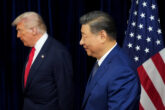January 25, 2024
How the West Can Match Russia in Drone Innovation
This article was originally published in War on the Rocks.
Since the start of Russia’s invasion of Ukraine, the use of AI for military operations has been one of the most debated topics across public media and the open-source literature. But for all the praise Ukrainian innovation has garnered, there is too little recognition of how effective Russia’s more reckless approach to AI has been.
Ukrainian and Russian forces have used AI for decision-making and data analysis when processing information received from multiple sensors and observation points, including drones, uncrewed aerial vehicles, manned aircraft, satellites, and ground-based forces and systems. But there have also been differences in the way both sides employed AI. Ukrainian and Western AI has focused on fast identification, tracking, and targeting. Russia, in turn, has used loitering munitions, as well as different command and control and intelligence, surveillance, and reconnaissance systems, to meet its need for precision targeting.
The war in Ukraine is pushing innovation on both sides to the limit, forcing the adversaries to adapt and adopt the latest in military and civilian technologies for combat.
Put simply, the focus of Western AI-enabled systems is on the left side of the observe, orient, decide, and act loop. But while the West prioritizes faster targeting and enhanced warfighter capabilities, Russia is attempting to make strides to automate the entire kill chain. In short, Russia’s aggressive military and volunteer-driven AI use stands in contrast to the United States’ cautious and responsible, if under-resourced, approach. Now, the U.S. Department of Defense needs to urgently prioritize AI assurance to ethically compete in the dynamic AI battlefield.
Read the full article from War on the Rocks.
More from CNAS
-
Transatlantic Security / Technology & National Security
Look Before We Leap on Artificial IntelligenceThis article was originally published on The Dispatch. A debate about the role that artificial intelligence should and will play in society, and how it will affect humanity fo...
By Jon B. Wolfsthal
-
Technology & National Security
Caleb Withers on the Cybersecurity Frontier in the Age of AICaleb Withers, research associate at the Center for a New American Security, joins Kevin Frazier, the AI Innovation and Law Fellow at the University of Texas School of Law and...
By Caleb Withers
-
Technology & National Security
Prepared, Not ParalyzedExecutive Summary The Trump administration has embraced a pro-innovation approach to artificial intelligence (AI) policy. Its AI Action Plan, released July 2025, underscores t...
By Janet Egan, Spencer Michaels & Caleb Withers
-
Indo-Pacific Security / Technology & National Security
Sharper: Tech + ChinaRecent talks between President Donald Trump and Chinese Communist Party General Secretary Xi Jinping placed a spotlight on emerging technologies, from high-end chips to minera...
By Charles Horn & Sevi Silvia




